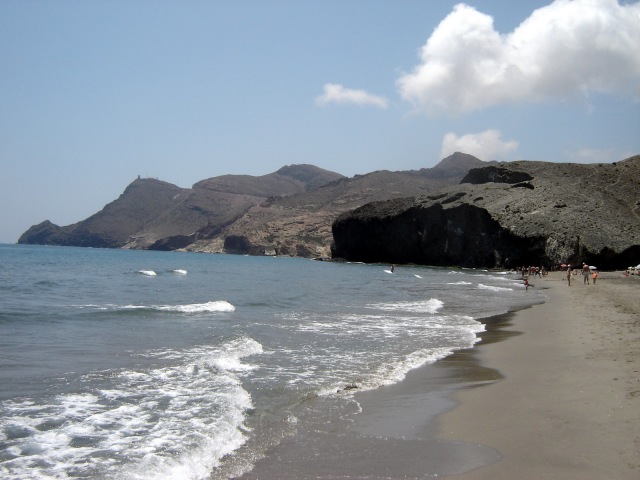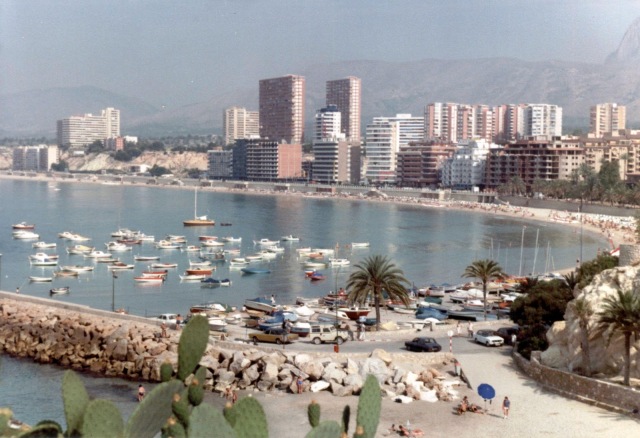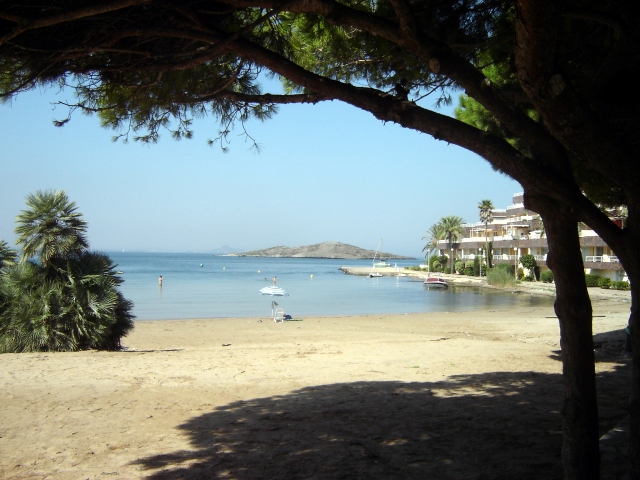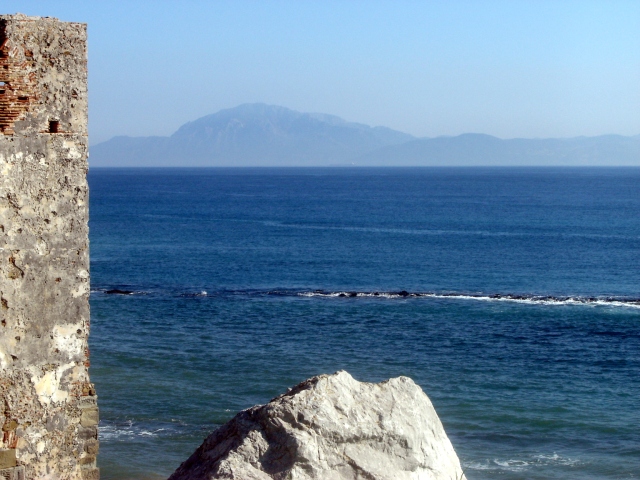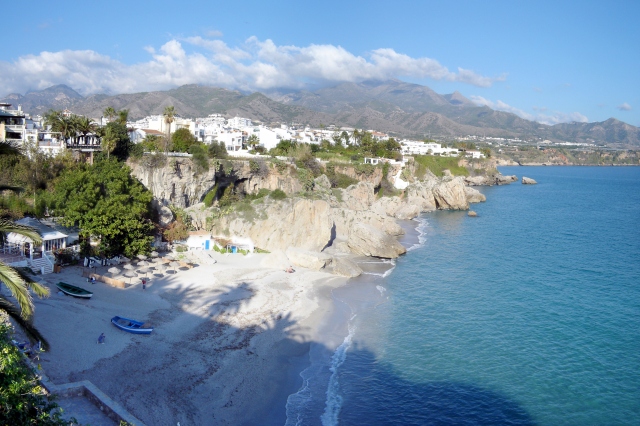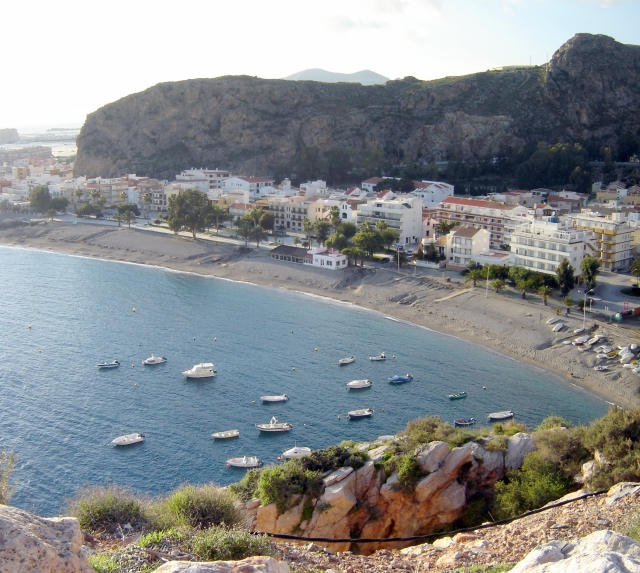by Robert Bovington
Costa AlmeríaThe coastline of Almería is dotted with virgin beaches, particularly in the natural park of the Cabo de Gata-Níjar. Some of the coves here are only reachable on foot. Northeast of this spectacular park is Mojácar - a Moorish fortress town standing on a towering crag overlooking the sparkling waters of the Mediterranean.
I quite like Mojácar Pueblo with its maze of steep winding streets, old houses and tiny bars. However, it is rather touristy and has several souvenir shops. I do not like Mojácar Playa but many English people do. There are too many English bars and shops along the long coastal strip for my liking.
I much prefer Roquetas de Mar but then I am biased as I chose to live here! The town does not have the brash, mass tourism of other Spanish resorts. Life here moves at a much gentler pace. There is a tourist area, in the Playa Serena part of the town, and it does have British and German bars and restaurants but these stand alongside typically Spanish hostelries.
At the south-western end of the Costa Almería, there is the resort of Almerimar, which has a fine marina, golf courses, hotels and many holiday homes and apartments.
 |
| Playa Monsul (Cabo de Gata, Almería) |
Costa BlancaTwo thousand five hundred years ago, Greek traders founded the colony of Akra Leuka, meaning 'White Headland', near to present day Alicante. Successive invaders have colonised this area of Spain and not for nothing is it called the Costa Blanca. The brilliant light and the endless miles of white sandy beaches make the 'White Coast' one of Spain's favourite tourist areas.
It is the coastal region of the province of Alicante and extends from the town of Dénia in the north to Torrevieja in the south, and includes the major tourist destinations of Benidorm and Alicante.
Other popular places to visit are Calpe and Altea. Calpe was formerly a fishing village and has fine sandy beaches that are overlooked by the imposing rocky outcrop of the Peñon de Ifach. Altea is a pretty little town. Its old quarter has escaped the ravages of mass tourism - it is a perfectly preserved labyrinth of steep narrow alleys between whitewashed houses dominated by a blue-domed church.
 |
| Benidorm |
Costa BravaThe Costa Brava is the most northerly coastal strip of Catalonia extending from Portbou near the border with France down to Blanes, the most southerly town in the province of Gerona near the border with the province of Barcelona. This stretch of the Catalonian coast is extremely rugged - waves of mountain ranges plunge abruptly into the sea.
The Costa Brava or 'rugged coast' has been a major holiday destination since the 1950s when Franco's government identified the area as suitable for the development of tourism. Since that time, seaside resorts such as Tossa de Mar, Lloret de Mar and l'Estartit have attracted millions of visitors from Northern Europe and especially the United Kingdom.
Not all the places along this coastal strip have had large-scale development - there are many small towns and fishing villages. The scenery of the Costa Brava captivated artists like Salvador Dalí and Pablo Picasso where the intense light and the raging fury of the sea were a constant source of inspiration. No more so than the little town of Cadaques where Dalí spent many years and where the Casa Dalí Museum is situated.
 |
| Calella (Costa Brava) |
Costa CálidaThe Costa Cálida is the province of Murcia's seaside. It extends from El Mojón near the border with Alicante to Águilas near the border with Almería province. This 250-kilometre coastline is known as the Costa Cálida or 'Warm Coast' because of its favourable year-round temperature.
Near the northern end of this coastline is Mar Menor or 'Little Sea' - Europe's largest coastal saltwater lagoon. It is separated from the Mediterranean by a 22-kilometre strip of land called La Manga on which is built La Manga del Mar Menor a major tourist resort.
The biggest city on the Costa Cálida is Cartagena. It is a major port and the site of Spain's chief Mediterranean naval base. Because of its long history - the Carthaginians first founded it circa 230 BC - there are many historical monuments in the city including Punic and Roman sites, 19th century mansions and Modernist architecture.
 |
| La Manga - Cala del Pino |
Costa de la LuzThe Costa de la Luz extends all the way from the Straits of Gibraltar to the Portuguese border. This 'Coast of Light' is the coastline of both Cádiz and Huelva provinces in Andalucía. It is cooler than the neighbouring Costa del Sol because of the influence of the Atlantic.
This coastline has miles and miles of wide sandy beaches backed by pine groves. Much of the Costa de la Luz is unspoiled. There are a number of resorts but they are mostly Spanish in character.
There are three major towns along this coast - Tarifa, Cádiz and Huelva whilst the sherry town of Jerez is only a few kilometres inland. Tarifa is close to Gibraltar and is the most southerly point in Europe. It is only a few kilometres from the North African coast. Cádiz is midway along this beautiful coast. It is claimed to be the oldest city in Europe and legend has it that Hercules founded it. Huelva is quite close to the Portuguese border and is the capital of the province of the same name.
Located between Cádiz and Huelva is the Doñana National Park which is home to 150 species of birds. It is Spain's largest national park.
 |
| The coast of Morocco viewed from Tarifa (Cádiz) |
Costa del AzaharThe coastal region of the province of Castellón is known to the Spanish as the Costa del Azahar and by English-speaking people as the 'Orange Blossom Coast' which is not entirely accurate because Azahar means orange or lemon blossom. In fact, this beautiful coast of white sandy beaches is bordered by mile upon mile of orange groves. There are also many lemon groves and fields of almond so, 'Orange, Lemon and Almond Blossom Coast' would be a more appropriate name!
The Costa del Azahar is adjacent to the Costa Brava - its southernmost point is at Gandia in the province of Valencia. The northernmost point of this coastal region is at the border of Castellón and Catalonia.
This coast is less commercialised than its brash neighbour and there are some delightful resorts - like Peñíscola with its sandy beaches dominated by a medieval castle built on a rocky promontory. Other resorts include Viñaros, Oliva, Benicassim and Torreblanca.
The main towns of the Costa del Azahar are Valencia and Castelló de la Plana. Valencia is Spain's third largest city. It is famous for its 'Fiesta de Las Fallas' - the pyrotechnic spectacular held during March every year. Of course, like other major towns, it has its fair share of historical monuments and museums but it has also entered the modern age - it is known as the 'City of Arts and Sciences'. The 'Ciudad de las artes y las Ciencias' is a huge parkland of futuristic buildings dedicated to fun and learning.
Castelló de la Plana is the capital of the province of Castellón. It has several historic buildings in the old part of the city including the 14th-century Gothic-style Santa María Church.
Costa del SolThe Costa del Sol is essentially the coastal areas of Málaga province in the south of Spain. This 'Sun Coast' stretches from Estepona in the west to Nerja in the east of the province.
Originally, it was a region of quiet fishing settlements but since the 1950s, it has become a massive urban abomination - sorry - agglomeration of high-rise hotels and apartment blocks running the length of the coastline.
This Mediterranean coastline includes the towns of Nerja, Vélez-Málaga, Torremolinos, Benalmádena, Fuengirola, Mijas, Marbella, Puerto Banús and Estepona together with the city of Málaga.
In my opinion, this coastal region suffers from all the worst excesses of mass tourism - a concrete jungle with parades of bars, supermarkets and shops selling cheap souvenirs and beachwear. 'Full English Breakfast', 'Fish n Chips', 'John Smiths Smooth Bitter', 'Football on Sky TV tonight!' appear on the signs outside many establishments. I think Spain is a fantastic country with beautiful cities and spectacular natural parks and yet the majority of British visitors to Spain head for the Costa del Sol. The good news, of course, is that it leaves the other areas of Spain free from beer swilling, football shirt-clad morons!
To be fair, not all the towns in this coastal strip are that bad - some are rather pleasant to live or visit including Marbella, Nerja and Mijas.
Marbella is rather swish. It is a jet-setting resort with many luxurious holiday complexes, mansions and shops yet despite this opulence it has managed to preserve its old Moorish quarter with its maze of winding streets and whitewashed houses.
Nerja too consists of whitewashed alleyways, though the old Moorish houses here are perched on a rocky promontory. There are magnificent views of the Mediterranean below especially from the Balcón de Europa.
Mijas is one of my favourite places. It is situated in the foothills of the coastal mountain range that overlooks the coast - from the gardens of 'La Muralla' there are magnificent views of the coast below. This park is a quiet oasis away from the bustle of tourists, yet is only a few minutes walk to the centre of the village. Its maze of old Moorish streets are awash with colour - pottery, basketwork and other goods are displayed in the many shops and colourful floral displays adorn the walls of the houses. Mijas is a good place to get away from the urban sprawl of Fuengirola.
Another delightful place to visit is Puerto Banús. It is a magnificent marina filled with the most luxurious yachts imaginable. Alongside the moorings stand a huge array of luxury shops and plush restaurants where it is quite common to see Ferraris, Mercedes and other luxurious cars parked.
The main city in these parts is Málaga. Even though it is the international gateway to the Costa de Sol, Málaga has escaped the depressing image of brash tourism. In fact, it is refreshingly Spanish and has many examples of historic architecture, excellent museums and leafy parks and gardens. Just some of the sights on offer are the Alcazaba, Gibralfaro Castle, the Cathedral and the Palacio Episcopal. The Picasso Museum is well worth a visit.
 |
| Nerja - view from Balcón de Europa |
Costa Dorada
The Costa Dorada is the coastal region of southern Catalonia and extends from Barcelona down to the Ebro delta. This 'Golden Coast' is so called because it comprises over 200 kilometres of golden sands. These fine sandy beaches are washed by crystal clear waters and bordered by lush green mountains.
Sitges, Salou and Cambrils are the principle resorts of this region.
Salou is the biggest, more down-to-earth resort. Its main attractions are its theme parks like Port Aventura and Costa Caribe, its discos and its clubs. However, its beaches are pretty good and have 34 European Blue Flags for being the tidiest, safest and cleanest sparkling waters on the Mediterranean.
Sitges is more sophisticated and is popular with young weekenders from Barcelona. It has an old-world charm - its old town built on a promontory and there are a number of good museums there, especially those displaying works of art. The Cau Ferrat was the house-cum-studio of artist and writer Santiago Rusiñol and now houses work by famous artists including Picasso and El Greco. The Palau Mar I Cel was built by American Charles Deering to house his art collection and many paintings and objets d'art are on display there. The Museu Romàntic is a perfectly preserved 19th century house displaying the lifestyle of a family of Catalan householders.
Cambrils is a traditional Spanish fishing town, with narrow cobbled streets, traditional old buildings and excellent seafood restaurants. Fishing is still a feature of the town's economy - the fishing boats look rather odd with their large lamps that enable the fishermen to fish at night.
There are two major cities on the Costa Dorada - Barcelona and Tarragona.
..
Costa TropicalThe Costa Tropical is the coastal region of the province of Granada sandwiched between the Costa del Sol to the west and the Costa Almería in the east. It is called the Costa Tropical because of the exotic fruits that grow there. Its unique microclimate has enabled the cultivation of chirimoya, mango, kiwi, avocado and sugar cane.
Some of the guidebooks claim that the Costa Tropical is quite picturesque - probably because there are no high-rise hotels or apartment blocks nor many tourists. However, in my opinion, much of this coastal strip is spoiled by the ingress of the invernaderos - the plastic greenhouses that have become a feature of the west of Almería province. Nevertheless, I would concede that there are some delightful stretches of this coastal region. In particular, Almuñecar and Salobreña are extremely attractive.
Almuñecar derives from the Arabic name Hins-al-Monacar, or fortress city. The old town is strategically positioned on the top of a hill. The town has a long history dating from Phoenician times and much evidence of its historic past can be found there - the Castillo de San Miguel being the most obvious example. There are relics of its Roman occupants - aquaducts, baths, bridges, tombs and palaces. Evidence of the Moors occupation can be seen in the streets and buildings of the old town.
Other sites are the necropolis from the 7th century BC, a 4th century fish salting plant and a number of churches dating from the Christian reconquest.
Salobreña is rather splendid especially as viewed from a distance. It has been described as the Jewel of the Tropical Coast - swathes of whitewashed houses tumble down the sides of the Gran Peñón, a rocky outcrop crowned by a Moorish castle. The old town's narrow streets are awash with bougainvillaea. From here one can look down on orchards of sub-tropical fruit trees and sugar cane plantations as well as Salobrena's modern development - not the ugly tower blocks of its Costa del Sol neighbours but low-rise, attractive apartments gracefully spreading out towards the shoreline and the beaches of the Costa Tropical.
The biggest town in these parts is Motril. In the 18th century it was a small fishing village. Nowadays it is primarily a fishing port. It does have some attractive beaches and it is handily placed for driving to Granada and the Alpujarras. Its only claim to fame is the fact that Boabdil, the last king of Granada, lived there.
 |
| Calahonda (Granada) |
Costa Verde
I used to think that Spain was a land of sun-baked villages and crowded beaches - a land of bullfights, flamenco, fiestas and fantastic Moorish cities.
I was misguided. There exists a different Spain - a Spain of verdant landscapes, babbling brooks and plunging waterfalls. The regions of Cantabria, Galicia and the Asturias, in the north of Spain, are a world away from the parched landscapes of the south. Not for nothing is it known as Green Spain.
Galicia has a diverse coastline - rugged and isolated in the south, white sandy beaches in the north.
Cantabria has plenty of variety to offer the traveller. There are fishing villages and miles of unspoilt beaches and, inland, there are the Cantabrian Mountains that include the snow-capped heights of the Picos de Europa.
The Asturias also has beautiful sandy beaches and verdant countryside. The Picos de Europa National Park extends into this region also.
The coastal strip of these delightful regions is known as the Costa Verde.
..
Costa do MariscoThe Costa do Marisco or “Shellfish Coast” is a label given to the coast of Galicia. It consists of the Costa da Morte; the Rías Altas and the Rías Baixas.
The Rías Altas ("Upper Rias") refers to the coast of the northern part of La Coruña province and the entire coastline of the province of Lugo. Ferrol is the largest city in these parts and is a major seaport.
The Rías Baixas ("Lower Rias") are a series of estuaries located on the southwestern coast of Galicia. The northernmost Rías Baixas begin below Cape Finisterre while the southernmost rias border the Portuguese coast, taking up the southern part of the province of Coruña and the entire Province of Pontevedra.
Lying between the relatively sheltered Upper and Lower Rias is the Costa da Morte or “Coast of Death” situated in the northern part of Coruña. The Costa da Morte received its name because of its treacherous rocky shore, exposed as it to the Atlantic Ocean. It is an area of shipwrecks, pirates and sea legends. Thousands have died and ships continue to sink along this treacherous coast and on a number of occasions Galicia's granite coastline has been painted black by oil spillages from stricken oil tankers.
Robert Bovington
https://sites.google.com/site/spanishimpressions/home
more blogs by Robert Bovington...
"Photographs of Spain" | |
"postcards from Spain" | |
"you couldn't make it up!" | |
"a grumpy old man in Spain" | |
"bits and bobs" | |
"Spanish Expressions" | |
"Spanish Art" | |
"Books About Spain" | |



